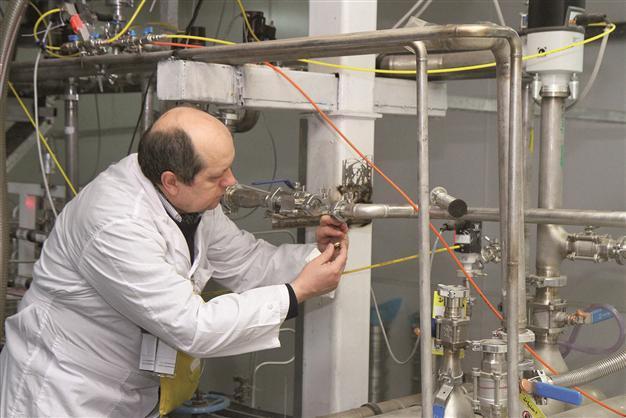Iran's most sensitive uranium stockpile falls after nuclear deal
VIENNA - Reuters

AFP Photo
The size of Iran's most contested uranium stockpile has declined significantly for the first time in four years following a landmark nuclear deal with world powers in November, the U.N. atomic watchdog reported on Thursday.
As a result, Iran's holding of uranium gas enriched to a fissile purity of 20 percent - a relatively short technical step away from the level required for nuclear weapons - is now well below the amount needed for a bomb, if processed more.
That stockpile is closely watched: Israel, Iran's arch-enemy and believed to be the Middle East's only nuclear-armed power, warned in 2012 that there would be a "red line" for possible military action against Iranian nuclear sites if its Tehran amassed enough such refined uranium for a single bomb.
Iran agreed under a Nov. 24 deal with six big powers to shelve its 20 percent enrichment, begun in 2010. It has since diluted some of this uranium to a lower concentration and converted some into less proliferation-prone oxide.
"That decrease has been quite important," a senior diplomat familiar with Iran's nuclear programme said, and the "progress has been quite substantial in terms of inventory."
Thursday's report by the International Atomic Energy Agency (IAEA) also showed, as reported by Reuters earlier this week, that the Islamic Republic was meeting its commitments under the November accord to rein in its most sensitive nuclear activity in exchange for some relief from economic sanctions.
"Things are progressing as planned," the diplomat said.
The IAEA report was issued to member states just hours after Iran and the six powers - the United States, France, Germany, Britain, China and Russia - completed a first round of negotiations in Vienna aimed at a final settlement of the decade-old dispute over the nature of Tehran's nuclear activity. The next round was set for March 17.
U.N. nuclear inspectors are playing a critical role in monitoring that Iran is living up to its side of last year's six-month accord, designed to buy time for the negotiations on a comprehensive agreement over atomic activity Tehran says is entirely peaceful but the West fears may have military designs.
Iran's reserve of 20 percent uranium gas fell to 161 kg (354 pounds) in February from about 196 kg (431 pounds) in November, the IAEA said. About 250 kg (550 pounds) is needed for the core of one nuclear warhead, experts say.
Iran justified its 20 percent enrichment drive by saying it was meant to replenish the fuel supply of a Tehran medical research reactor, but Western officials were sceptical, saying Iran had refined far more than it required for such a purpose.
However, the IAEA report showed the stock of low-enriched uranium (LEU) - or 5 percent purity - increased to 7,609 kg (16,740 pounds) from 7,154 kg (15,739 pounds) in November.
This arose apparently from a delay in building a plant to convert some of the material into an oxide form less suitable for processing into high-enriched bomb material.
Parchin 'building materail and debris'
LEU is normally used to fuel nuclear power plants, the stated purpose of Iran's nuclear programme, but can also provide material for nuclear weapons if refined to the 80-90 percent threshold.
The interim agreement took effect on Jan. 20 and the IAEA gave an update about its implementation on Thursday, together with a regular quarterly report on Iran's atomic activities.
While Iran a month ago stopped 20 percent enrichment, it is allowed under the November pact to keep producing uranium refined to up to 5 percent.
But it agreed to limit its LEU reserve and the new conversion plant is meant to help achieve that.
Diplomats said this matter was of no immediate concern since Iran's commitment concerned the size of the stockpile towards the end of the deal, in late July, giving it time both to complete the facility and convert enough material.
Proliferation experts say Iran potentially has enough LEU for a few nuclear weapons if refined much further. Limiting its overall enrichment capacity will be one of the thorniest issues in the negotiations launched this week.
The IAEA also said Iran had told it about preliminary site selection for five new enrichment sites but that there would be no new such plants during the half-year deal with the powers.
If Iran were to implement these plans - first announced during the 2005-2013 presidency of nationalist hardliner Mahmoud Ahmadinejad - it would probably wreck any chance of a final treaty with the major powers. Ahmadinejad's moderate successor, Hassan Rouhani, has initiated a thaw with the West.
Iran has also informed the IAEA of a new planned research reactor that would use 20 percent uranium oxide as fuel.
The IAEA repeated its request to visit the Parchin military base, a site southeast of Tehran where it believes - based on Western intelligence information - that Iran may have conducted nuclear weapons-related explosives tests. Iran denies this.
The IAEA has indicated that it suspects Iran has tried to purge the site of any incriminating evidence. Thursday's report said it had observed via satellite imagery "possible building material and debris" there. The report did not elaborate.
